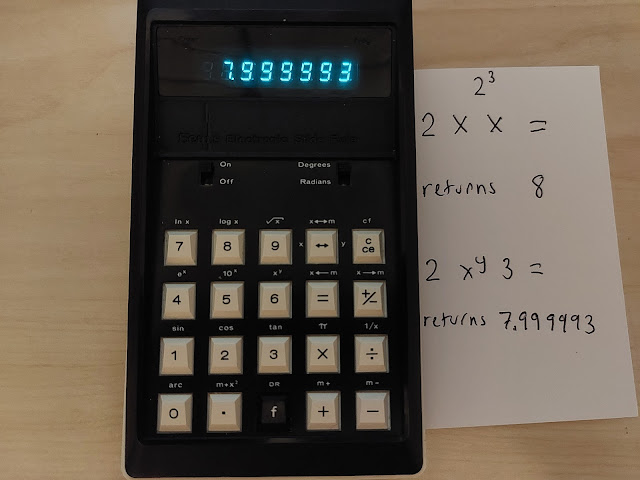Retro Review: Sears Electronic Slide Rule
Quick Facts
Model: Electric Slide Rule, 801.58771
Company: Sears
Production Years: 1974 - mid 1970s
Power: Battery, originally AA chargeable NiCad*
Type: Scientific
Operating System: Chain
Memory Registers: 1
Display: One line: 8 digits, 2 lights: one for overflow (error), one for negative numbers
Same Key Set as: Rockwell 61R
* I purchased this calculator at the Pasadena City College Swap Meet on July 2, 2023. The calculator is in great condition, along with a great leather case and instruction manual. The calculator was re-configured to run on 4 regular AA batteries, to that I'm very grateful.
Keyboard and Scientific Functions
Most of the functions available are shifted functions. The equals key is in an usual place, on the 2nd row from the top, above the arithmetic keys. Access the shifted functions (written in white) by pressing the black key [ f ].
Scientific Functions Available:
Logarithm: ln, log, e^x, 10^x
Roots and Powers: √x, x^y, 1/x
Trigonometry: sin, cos, tan, arc (inverse)
Memory Functions: m+, m-, m+x^2 (add the square of a display to memory) x←m (recall), x→m (store), x←→m (exchange with memory), x←→y (swap arguments, not shifted)
DR: Data Recovery function is activated the key sequence [ f ] [ f ] (not a typo, DR is the shifted function of [ f ]). What this does is two-fold:
1. Erase the last number entered.
2. Activate the intended shifted function without having the need to press [ f ] again.
Example: e^4
[ 4 ] [ 4 ]: Display: 44
[ f ] [ f ]: Erases the last 4, Display: 4
[ 4 ]: Calculates e^4, Display: 54.59814
CF: Clear Function. Cancels out the shifted function [ f ].
Example: 12 + 89
[ 1 ] [ 2 ] [ + ]
[ f ]: next key pressed will be a shifted function
[ c ce ] (cf): cancels out that shifted function
[ 8 ] [ 8 ] [ = ]: Display: 100
There are two switches: Power (On/Off) on the left, and Angle mode (Degrees/Radians) on the right.
Negative Numbers
There was no room on the display for a negative sign (apparently), instead negative numbers are indicated by a bright red light on the upper right hand of the display, next to the clear Neg imprint on the screen.
I would prefer the negative sign on the display, to the left of the number.
Chain Mode
The Slide Rule operates in chain mode, which is the calculations happen exactly the way they are entered, with no respect to the order of operations. Note that there are no parenthesis keys.
For example:
4 + 3 × 8 returns 56
3 × 8 + 4 returns 28
Powers
Assume that n is a positive integer.
a^n can be accomplished by entering a, repeatedly pressing [ × ] n-1 times, finishing by pressing [ = ].
7^5: 7 [ × ] [ × ] [ × ] [ × ] [ = ]. Result: 16807
[ × ] four times.
1/(a^n) can be accomplished by entering a, repeatedly pressing [ ÷ ] n+1 times, finish by pressing [ = ].
4^-3:
4 [ ÷ ]: Display: 4
[ ÷ ]: Display: 1 (4^0 = 1)
[ ÷ ]: Display: 0.25 (4^-1 = 1/4)
[ ÷ ]: Display : 0.0625 (4^-2 = 1/16)
[ = ]: Display: 0.015625 (4^-3 = 1/64)
The power function x^y operates on the formula e^(y × ln x). This may lead to rounding errors.
Example:
2^3 = 8.
2 [ × ] [ × ] [ = ] returns 8. The exact answer.
2 [ f ] [ 6 ] (x^y) 3 [ = ] returns 7.999993
Floating Point Rounding Errors
One drawback of the Electronic Slide rule is the rounding floating point errors.
70 [ f ] [ ÷ ] (1/x) returns 0.0142857
Press [ f ] [ ÷ ] (1/x) again returns 70.00007
0.5 [ f ] [ 0 ] (arc) [ 2 ] (cos) returns 59.99999 degrees (it should be 60 degrees)
The forensic test returns 10.4382 (9 sin cos tan arctan arccos arcsin).
I think the calculator can handle numbers to what the display capacity allows. There is no internal guard digits to help with accuracy.
Final Thoughts
I like the feel of the calculator. The screen has large green numbers which makes the display easy to read. The keys are are pretty responsive, especially back in the day when it comes to lower-cost calculators in the 1970s (around $100).
I am not the biggest fan of the negative number indicator, the Rockwell 61R has a negative sign. Not a deal breaker, though. The good thing is that red indicator light is bright.
The Slide Rule is great for fans of Chain Mode (non-algebraic mode).
If you buy one be sure that: the charging cord and rechargeable batteries are included and in good working order or the calculator is modified to work on regular AA batteries.
I like how the manual goes in depth with the operations and its library of applications.
Sources:
Download the manual from Katie Wasserman's Page:
Sears Electronic Slide Rule:
https://www.wass.net/manuals/Sears%20Slide%20Rule.pdf
Rockwell 61R:
https://www.wass.net/manuals/Rockwell%2061R.pdf
calculator.org's page on the Sears Electronic Slide Rule (retrieved July 2, 2023):
https://www.calculator.org/calculators/Sears_Electronic_Slide_Rule.html
Eddie
All original content copyright, © 2011-2023. Edward Shore. Unauthorized use and/or unauthorized distribution for commercial purposes without express and written permission from the author is strictly prohibited. This blog entry may be distributed for noncommercial purposes, provided that full credit is given to the author.


